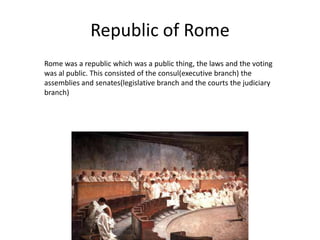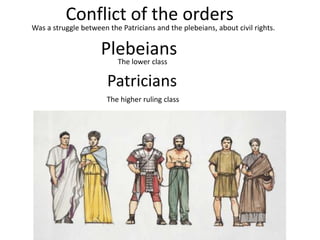Romans
- 1. Government of the Roman Republic
- 2. Senate Once elected as a senate, you are in for life.
- 3. Roman Consuls Consuls are military commanders and chiefs that elect public officials. Consuls could execute people. There were two consuls so not too much power was given to one person. One consul could veto the other person decisions.
- 4. Roman Dictator Could rule as a temporary dictator for 6 months if an emergency occurred.
- 5. Tribunes Tribunes were protected and held power for the plebeians. The Tribunes could veto any law made by the senate.
- 6. Republic of Rome Rome was a republic which was a public thing, the laws and the voting was al public. This consisted of the consul(executive branch) the assemblies and senates(legislative branch and the courts the judiciary branch)
- 7. Conflict of the orders Was a struggle between the Patricians and the plebeians, about civil rights. Plebeians The lower class Patricians The higher ruling class
- 8. Assembly of the Plebs An assembly that presided all the tribunes. They allowed an expanded democracy for plebeians. Plebeians could elect officials, try criminal cases involving plebeians, and pass the legislation.
- 9. Censor An office that is used to collect taxes and organize military duties for the citizens of Rome.
- 10. Praetor An officer of the law put there to be in charge of the judiciary and to lead the armies as needed. Collected annually!!!!!!
- 11. 12 Tables They are the written code of law for Rome at the time. They were written on 12 bronze tablets.










